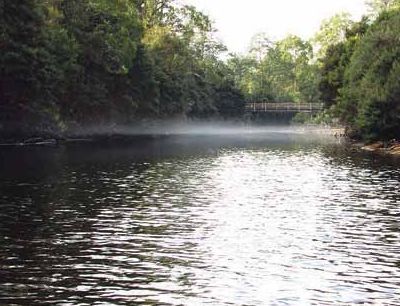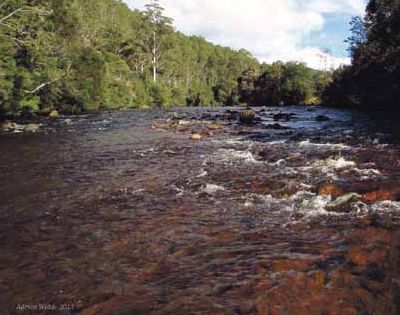 Presented from Issue 108, February 2014
Presented from Issue 108, February 2014
I believe the Leven River to be one of the best rivers in Northern Tasmania. It flows freely from Black Bluff Range below Mt.Tor, through Loongana and the Leven Canyon. It then flows through the farmland district of Gunns Plains all the way to the estuary at the seaside township of Ulverstone. There is not a single dam on this beautiful river to interrupt its natural flow and that is great. The river above the Loongana Bridge is now classed as a rainbow water, and below it is classed as a brown trout fishery, and a very good one it is.
Refer to https://m.ifs.tas.gov.au/about-us/publications/river-leven-angler-access-brochure for current information.
Around Loongana there are Angler Access points on Loongana Bridge and further upstream at Taylor’s Flats. See the map on page 9 or pick up a brochure from your local tackle store. The river here can be waded and just below the bridge is a long stretch of medium to deep water ideal for bait fishing. If you do decide to fish the Loongana area remember to make sure you are not low on fuel or food as these two items are not available here. Don’t forget you also have a chance of catching both brown and rainbow trout at Loongana, and maybe even the elusive native black fish as well.
 |
| Leven upstream of Taylors Bridge |
The waters above Gunns Plains in the Leven Canyon can be quite strenuous on the body as most sections of the river are quite tough going due to it being strewn with large rocks. This area is rugged, but spectacular and you also have a chance to catch a few rainbow trout here as well as the browns. This section of river is mainly fast water and is quite good for spinning and fly fishing. The rewards can be worthwhile as the fishing in this long stretch of river is well worth the effort put into it, especially in the warmer months of the season. They are not big trout and would average 330gms with the odd fish going close to the kilo mark. This area is for the young and the fit fishermen that’s for sure as there’s no easy way in or out of this area of the river.
Below the Leven Canyon is Gunns Plains and there are many Anglers Access points that are available to the public due to the permission from the various landowners and a lot of negotiation and hard work by the Inland Fisheries Service. Without the time and effort that the IFS and AAT put into getting this project off the ground, we may never have had the access to so many great sections of the river that we have today. There is some excellent trout fishing to be had in the Gunns Plains area, so please respect the areas that you enter and fish.
Please do not LITTER where you are fishing, take it away with you. Camping is allowed for a small fee next to the Wings Wildlife Park, enquire at the park for access and fees. The Wildlife parks is also well worth a visit too. The flatter farmland area here is much easier to access and not as hard on the body, especially for us older fishermen. There is ample parking and access in most areas at Gunns Plains. Popular access points are at Marshall’s Bridge, Bannon Park and the Lee Memorial Park and in these areas you can go off fly fishing, spinning or just sit back with a bait in the river and wait for a bite. There are plenty of roadside signs so you should find your way quite easily.
Brown trout is the main catch in this area and they are quite plentiful, though not real big fish the majority would go around the 350gm mark which is a reasonably good size river fish. The river right through this area is at most times wade-able unless there has been considerable rainfall above Loongana. The start of the trout season when there is usually a good flow of water due to winter rains, bait fishing with worms is very popular and a nice bag of fish can be caught. I have found the best time to fish this area has been from November onwards as the weather improves and the days become that little bit warmer. Even at this time of year there can still be some very wet, cold days so always have a jumper and waterproof outfit with you. There is also one other area where you can camp and this is Bannons Park next to the bridge, toilets are also there for your convenience. Getting back to fishing the Leven River, don’t forget to use the Angler Access areas available for use.
With the stiles having been set up for easy access over barb wire fences thus saving one from tearing the crutch out of your pants or ripping open your waders its made it much easier, so please use them. It has opened sections of river that a lot of fishermen had never fished previously, myself included. On one stretch of water that I fished for the first time since the stiles were installed is where I had one of my best days fishing in this river. The Leven River has quite a lot of long fast water sections and is my favourite type of water that I love to fish, and there are also many stretches of slow moving water that’s ideal for the fly and bait fisherman too. For me being a spin fisher (small 1.5 gm metal blades) these tiny little spinners work extremely well in this type of water and using the Gold & Black colours, working every bit of river I finished up having sixty one hook ups and caught and released forty five trout for the day - hooked and lost the other sixteen.
There are many other areas just like this that are now accessible, and I have fished these with a lot of success. As you will find when you do come to fish the upper reaches at Loongana, or the flat pasture area of Gunns Plains there will be a stretch of the Leven River you will be over whelmed by it and want to keep on going back to this great river. In all of my trips to different sections of this great river I have managed to catch and release quite a lot of brown trout and many rainbows.
During the warmer months of late January through March is when the grasshoppers are out and about and these are the best fish takers that you can put on a hook. I have a kids butterfly net in the back of my car and this is ideal for catching them. When caught keep them in a clear container as this will keep them used to the light. If they are kept in dark containers, as soon as the lid is opened they will head for the light and you will lose the majority of your hoppers. After your days fishing they can be taken home (with a feed of trout hopefully) and kept in the bottom of the fridge, this makes them go into a state of hibernation and can be kept for several weeks. Always put some grass in the container and even a little mist spray of water in with them and do not leave the container out in the sun when fishing. The more they move on the water surface the better are your chances of catching a trout. I use a little piece of cork connected about a meter above a size 6 hook and just flick it out of a pool and let it drift down with the flow. By using this method it keeps the hopper on the surface making it much more inviting to the trout. So give this method a try when you go fishing this river or any other river in Tasmania when the grasshoppers are in season. When spin fishing the Leven River, you will catch more trout by wading. Get to the centre of the river where possible and cast to one river bank and work your way around 180degs to the other. This river is not over wide and it is easy to reach either side of it, in most sections it can be reached from casting from one side of the river bank.
 |
| Leven water - tannin and fast |
The stretch of the Leven in the Gunns Plains area varies from knee depth to around 1.8 mtrs, so like fishing any river care must be taken when wading. It also has a very rocky bottom, but is still reasonably easy to wade compared to some of the other rivers that I fish. For the majority of the year it has a slight tannin colour and this not uncommon with many of the rivers in Tasmania.
I have found that most of the brown trout taken in the Leven have a beautiful gold colour and the red spots really stand out on them. I’m not sure if this is due to the tannin water or not, but I have seen it in others that I have caught elsewhere in the same type of tannin water.
The next section of the Leven River that has Angler Access is in the Dial Range State Forest Recreation Reserve, and there is around 2 to 3 kms of river to fish. To reach this area you must travel into the beautiful seaside town of Penquin and take the Dial Road for several kilometres and keep your eyes open for the Anglers Access signs to the river. You then have a reasonable walk along the Penquin Trail Walk (keep an eye out for snakes here) to the river where it is wade-able. This section of the Leven River is more suited to the experienced angler, as you need to be quite accurate with casting the fly or spinner. Native forest runs right through this area, and that is why it is better left for the experienced fisherman.
Last but not least is the stretch along Lobster Creek Road and this area is affected by tidal movement and regularly fished by locals for the sea run trout early in the season. The seaward side of the Allison Bridge is open to fishing all year round and lure casting, fly and bait fishing are quite popular here. The choice of lures to fish the Leven River are many, such as the blade spinners like Celtas, Mepps, Vibrax,to name a few, all fish extremely well. Small light hard body rapalas and the like are effective, then you have the soft plastics that many fishermen have changed to. As for the fly fisher well you fellows will have your favourites that’s for sure. With me being a spin fisher I would not even have a guess of what to suggest, maybe a hopper pattern during February and March? Anyway give this great free flowing Leven River a fish you won’t regret it hopefully. A bag limit applies throughout this river system and a trout license must be obtained to fish any inland waters in Tasmania. The minimum length for Blackfish, Brown and Rainbow Trout is 220mm. Angler’s must observe the access signs and where access is not specifically identified you MUST get permission from the land owner before entering that area. When purchasing your IFS license remember to ask for your Fishing Code booklet as well as any Angler’s Access Brochures that are available for this and many other rivers around the state of Tasmania.
Adrian Webb





